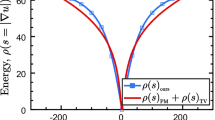Abstract
This paper mainly studies the algorithm of anisotropic diffusion for speckle noise removal of SAR images. Because the Gauss curvature driven diffusion method is sensitive to the noise and is of low efficiency on suppressing the speckle noise, an improved denoising algorithm is proposed. The new algorithm introduces the difference curvature as the diffusion coefficients of the function, which solves the problem that Gauss curvature driven diffusion is sensitive to the speckle noise, further, Tukey’s biweight function is used to control the curvature diffusion model, which can not only better protect edges, but also automatically control the diffusion. Numerical experiments show that the improved algorithm can preserve the information of textures, edges while inhibiting the speckle of SAR images.








Similar content being viewed by others
References
Alberto M (1991) Improved multilook techniques applied to SAR and SCANSAR images. IEEE Trans Geosci Remote Sens 23(4):534
Black MJ, Sapiro G, Marimont D et al (1998) Robust anistropic diffusion. IEEE Trans Image Process 7(3):421–432
Catte F et al (1992) Image selective smoothing and edge detection by nonlinear diffusion. SIAM J Num Anal 29(1):193
Chakrabarti S, Axel C, Gogineni P (2014) Application of specialpurpose artificial neural networks for speckle reduction in SAR images. Intl J Remote Sens 35(5):1804–18
Charbonnier P, Blanc-Feraud L, Aubert G et al (1997) Deterministic edgepreserving regularization in computed imaging. IEEE Trans Image Process 6(2):298–311
Chen Q, Montesinos P, Sun QS, Heng PA, Xia DS (2010) Adaptive total variation denoising based on difference curvature. Image Vis Comput 28(3):298–306
Di Martino G, Poderico et al (2014) Benchmarking framework for SAR despeckling. IEEE Trans Geosci Remote Sens 52:1615
Donoho DL (1995) Denoising by soft-threshoding. IEEE Trans Inf Theory 41(4):613–627
El- Fallah AI, Ford GE (1997) Mean curvature evolution and surface area scaling in image filtering. IEEE Trans Image Process 6:750–753
Fabbrini L, Greco M, Messina M, Pinelli G (2013) Improved anisotropic diffusion filtering for SAR image despeckling. Electron Lett 49(10):674
Fan H (2014) SAR image despeckling based on adaptive PDE filter and histogram. J Inf Comput Sci 11(7):2283–2290
Frost VS, Stiles JA, Shanmugan KS et al A model for radar images and its application to adaptive digital filtering of multiplicative noise. IEEE Trans 166
Gao Q, Lu et al (2013) Directionletbased denoising of SAR images using a Cauchy model. Signal Process 93(5):1056–1063
Gupta A, Tripathi A, Bhateja V Despeckling of SAR images via an improved anisotropic diffusion algorithm. Adv Intell Syst 754
Gupta A, Tripathi A, Bhateja V (2013) Despeckling of SAR images in contourlet domain using a new adaptive thresholding. Proceedings of the 1257–1261
Hua X, Pierce LE Ulaby F T.SAR speckle reduction using wavelet denoising and Markov Random field modeling. IEEE Trans Geosci 2211
Huang Q, Wang Y-F, Zhang B-C, Miao H (2006) New anisotropic diffusion method for SAR speckle reduction. Acta Electron Sin 34(9):1553–1557
Jidesh P, George S (2012) Gauss curvaturedriven image inpainting for image reconstruction. J Chin Inst Eng 37(1):122–133
Jin T, Zhou Z-M (2008) Study of key techniques in multi-look processing for vehicle-borne forwardlooking ground penetrating SAR. Dianzi Yu Xinxi Xuebao/J Electron Inf Technol 30(4):925–928
Kuan DT, Sawchuck AA, Strand TC et al Adaptive noise smoothing filter for images with signal dependent noise. IEEE Trans Pattern Anal 177
Lee JS (1980) Digital enhancement and noise filtering by use of local statistics. IEEE Trans Pattern Anal Mach Intell 2(2):165–168
Lee SH, Seo JK (2005) Noise removal with Gauss curvaturedriven diffusion. IEEE Trans Image Process 14(7):904–909
Li X (2005) Improved wavelet decoding via set theoretic estimation. IEEE Trans Circ Syst Video Technol 15:112
Lopes A, Nezry E, Touzi R Maximum a posteriori speckle filtering and first order texture model in SAR images. Proc IGARSS’90, 2412
Lu B, Wang H, Lin Z (2011) High order Gaussian curvature flow for image smoothing, in Multimedia Technology (ICMT), International 5891
Oliver C, Quegan S (1998) Understanding synthetic aperture radar images. Artech House, New York
Perona P, Malik J (1990) Scale-space and edge detection using anisotropic diffusion. IEEE Trans PAMI 12(7):629–639
Wang Z, Bovik AC (2002) A universal image quality index. In: IEEE Signal Process. Lett. 9:81–84
Yezzi AR (1998) Modified curvature motion for image smoothing and enhancement. IEEE Trans Image Process 7:345–352
Yu Y, Acton S (2002) Speckle reduction anisotropic diffusion. IEEE Tran Image Process 11(11):1260–1270
Acknowledgments
This work was supported by the National Natural Science Foundation of People’s Republic of China (Grant No. 91026005). I wish to thank Professor Wang LingYan who has contributed to the paper improvement.
Author information
Authors and Affiliations
Corresponding author
Rights and permissions
About this article
Cite this article
Gun, L., Cuihua, L., Yingpan, Z. et al. An improved speckle-reduction algorithm for SAR images based on anisotropic diffusion. Multimed Tools Appl 76, 17615–17632 (2017). https://doi.org/10.1007/s11042-015-2810-3
Received:
Revised:
Accepted:
Published:
Issue Date:
DOI: https://doi.org/10.1007/s11042-015-2810-3




